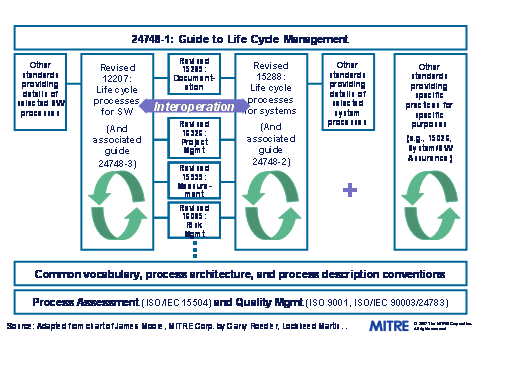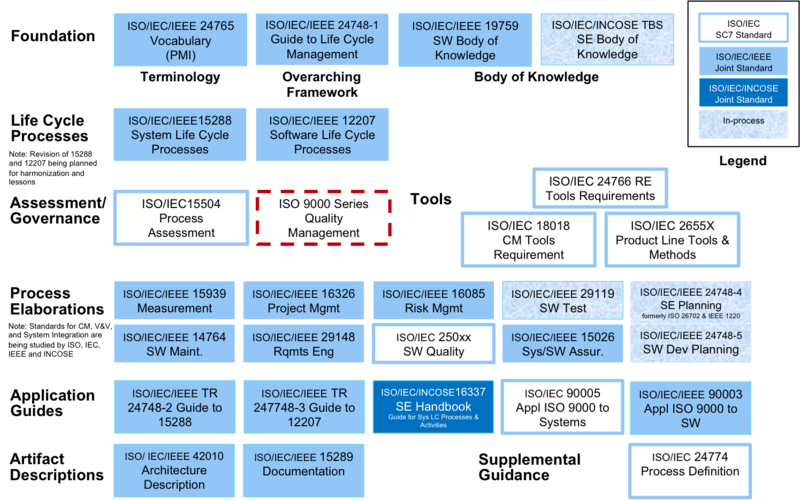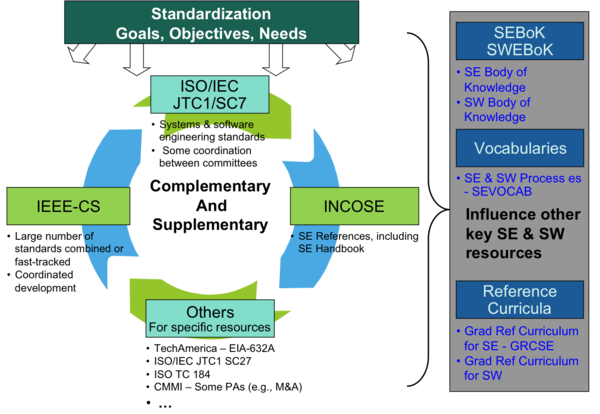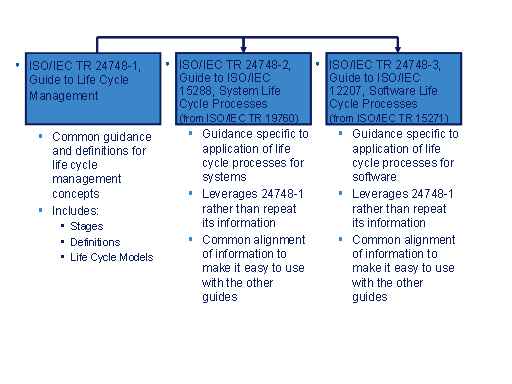Difference between revisions of "Alignment and Comparison of Systems Engineering Standards"
| Line 18: | Line 18: | ||
==Objective== | ==Objective== | ||
| − | The objective is to make the standards more usable together by achieving (Roedler 2010) | + | The objective is to make the standards more usable together by achieving (Roedler 2010) |
*Common vocabulary | *Common vocabulary | ||
*Single, integrated process set | *Single, integrated process set | ||
Revision as of 17:53, 23 August 2012
Over the past decade, a number of the standards development organizations (SDOs) and other industry associations have been working collaboratively to align the systems and software engineering standards. The objective is to have a set of standards that can easily be used concurrently within both engineering disciplines due to the disparity that often lies within their use of common terminology and concepts.
Problem
There has been a lack of integration both within and across SDOs. This has led to systems and software engineering standards that have different terminology, process sets, process structures, levels of prescription, and audiences. These differences have been both between systems and software, and to some extent, within each. The problem has been exacerbated, in whole or part, by competing standards (Roedler 2010).
Cause
The cause of this problem includes several factors, as follows (Roedler 2010):
- Culture - “We’re different”; “Not invented here”
- Organizational - Different teams, committees, etc.
- Competition - Many Standards Development Organizations
- Domains - Focused, narrow view often doesn’t look beyond the domain for commonality
Impact
The impact of this problem includes the following (Roedler 2010):
- Less effective or efficient processes that are not focused on leveraging commonalities. This causes redundancy and has resulted in incompatibilities and inconsistencies between the standards making it difficult to concurrently use them together.
- Less effective solutions that are not focused on a common approach to solve a problem or need.
- Obstacle for communicating (at all levels), working in integrated teams, and leveraging resources.
- Stove-piping due to the incompatibilities, inconsistencies, and lack of leveraging commonalities.
Objective
The objective is to make the standards more usable together by achieving (Roedler 2010)
- Common vocabulary
- Single, integrated process set
- Single process structure
- Jointly planned level of prescription
- Suitable across the audiences
- Accounts for considerations in a wide range of domains and applications
Alignment of Systems Engineering Standards
Approach
A collaborative effort has been in place for the past decade that includes ISO/IEC JTC1/SC7 (Information Technology, Systems and Software Engineering), IEEE Computer Society, the International Council on Systems Engineering (INCOSE), and others. Figure 1 depicts the approach being used to align the standards through this collaboration. It is built around a foundational set of vocabulary, process definition conventions, and life cycle management concepts provided by ISO/IEC/IEEE 24765 (systems and software engineering vocabulary), ISO/IEC TR 24774 (guidelines for process description), and ISO/IEC/IEEE TR 24748-1 (guide to life cycle management), respectively. At the heart of the approach is the alignment of the ISO/IEC/IEEE 15288 (system life cycle processes) and ISO/IEC/IEEE 12207 (software life cycle processes), which provide the top level process framework for life cycle management of systems and software. This enables concurrent and consistent use of the standards to support both systems and software life cycle management on a single project. The approach includes the development or revision of a set of lower level supporting standards and technical reports for elaboration of specific processes, description of practices for specific purposes (e.g., systems/software assurance), description of artifacts, and guidance for the application of the standards.
Past Accomplishments
Significant progress has been made towards the alignment objectives for the groups discussed above. Figure 2 shows a May 2011 snapshot of the status of the standards that are being aligned. In addition, four of the standards shown as “In-process” are complete, but waiting for final publication. The set of standards span ISO/IEC, IEEE, INCOSE, and PMI. This figure depicts the standards in one of many possible taxonomies.
Current Efforts
A Life Cycle Process Harmonization Advisory Group has been evaluating the current standards for systems and software engineering. The objective of the group is to provide a set of recommendations for further harmonization of the industry standards. Specifically, its charter includes:
- Perform an architectural analysis and recommend a framework for an integrated set of process standards in software and IT systems domains
- Make recommendations regarding the future content, structure, and relationships of ISO/IEC 12207, ISO/IEC 15288 and their guides, as well as other related SC 7 documents
To support the development of the recommendations, process modeling of ISO/IEC/IEEE 15288 and ISO/IEC/IEEE 12207 has been performed and analyzed for consistency, completeness/gaps, and opportunities. In addition, analysis from other working groups, technical liaisons, and users of the standards has been collected. The output of this effort will be a harmonization strategy, set of recommendations for specific standards, and timing/sequencing recommendations (Roedler 2011).
Additionally, as the industry continues to consider harmonization needs of these standards, the collaboration has grown to include the work of the organizations and projects shown in Figure 3. These organizations are working towards the goal of completing a complementary and supplementary set of Systems Engineering resources that use the same terminology, principles, concepts, practices, and processes and can be used concurrently without issues.
Comparison of Systems Engineering Standards
See Figure 1 located in the Relevant Standards for Systems Engineering Article to see the breadth and level of detail for many of the SE related standards. Since EIA 632 (Engineering of a System) is currently in revision, a comparison of ISO/IEC/IEEE 15288 (System life cycle processes) and EIA 632 will be deferred until the revision is complete.
Figure 3 shows a comparison of the 3-part technical reports that provide life cycle management guidance. Part 1 is focused on the provision of common terminology and concepts that apply to both systems and software. Part 2 provides guidance that directly supports ISO/IEC/IEEE 15288 that is specific to systems. And Part 3 provides guidance that directly supports ISO/IEC/IEEE 12207 that is specific to software (Roedler 2010).
Practical Considerations
Key pitfalls and good practices related to systems engineering standards are described in the Relevant Standards article.
There are also instances in which standards groups for program management, safety, or other disciplines create standards on topics addressed within systems engineering but use different terminology, culture, etc. One such example is risk management, which has been dealt with by many professional societies from different perspectives.
Systems engineers must also be aware of the standards that govern the specialty disciplines that support systems engineering, as discussed in Part 6.
References
This article relies heavily on limited sources. Reviewers are requested to identify additional sources.
Works Cited
Roedler, Garry. 2010. An Overview of ISO/IEC/IEEE 15288, System Life Cycle Processes. Asian Pacific Council on Systems Engineering (APCOSE) Conference.
Roedler, Garry. 2011. Towards Integrated Systems and Software Engineering Standards. National Defense Industrial Association (NDIA) Conference.
Primary References
Roedler, Garry. 2010. An Overview of ISO/IEC/IEEE 15288, System Life Cycle Processes. Asian Pacific Council on Systems Engineering (APCOSE) Conference.
Additional References
See additional references in the Relevant Standards article.
SEBoK Discussion
Please provide your comments and feedback on the SEBoK below. You will need to log in to DISQUS using an existing account (e.g. Yahoo, Google, Facebook, Twitter, etc.) or create a DISQUS account. Simply type your comment in the text field below and DISQUS will guide you through the login or registration steps. Feedback will be archived and used for future updates to the SEBoK. If you provided a comment that is no longer listed, that comment has been adjudicated. You can view adjudication for comments submitted prior to SEBoK v. 1.0 at SEBoK Review and Adjudication. Later comments are addressed and changes are summarized in the Letter from the Editor and Acknowledgements and Release History.
If you would like to provide edits on this article, recommend new content, or make comments on the SEBoK as a whole, please see the SEBoK Sandbox.
blog comments powered by Disqus


